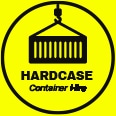Before purchasing a used shipping container, it is important to assess it for structural integrity to ensure that it is both safe and likely to last. While some issues are purely cosmetic and not to be concerned about, others may compromise the structure itself. It is essential to know the difference before you buy. We recommend personally performing an inspection on the container with the following points in mind:
Overall Shape
Shipping containers are often stacked and moved about significantly which, if not handled properly, can lead to structural issues to the box’s frame. The shape should be in-square. If it is leaning or warped, then damage has been done. We recommend doing a string test: Place one end of the string at a top corner of the container (on the longer side), while another person holds the other end of the string at the opposite bottom corner (diagonal). If the centre of the container is quite away from the string, it shows that your container has been warped.
Dents
Most used containers will have a few dents on them. Generally, small dents on the sides of the container present no real problem, they are purely aesthetic blemishes. If, however, the dent is big enough to change the overall shape of the container (makes it seem slanted, slouched or warped) the structural integrity of the container may have been compromised.
Get up high and check the dents on the roof of the container. Roof dents pool water and corrosion will set in. Check the degree of the corrosion. Then check the inside roof of the container for dents and visible corrosion.
Rust
Containers are made from super strong corten steel with high anti-rust properties. These properties delay the risk of rust but cannot completely prevent it. Over time, dents and scrapes that are exposed to the weather will begin to corrode. There are two types of rust that you should know about: Non-structural and structural.
Non-structural rust is surface level rust and is purely cosmetic. This type of rust is nothing to worry about and is easily repaired during regular maintenance.
Structural rust, however, is a real concern. Unlike the usual exterior rust, structural rust goes beneath the surface level and deep into the steel. If you see bubbling underneath the paint, this is a good indication that structural rust is present. It can render a container unusable.
The floor and undercarriage
The floor of a shipping container is the main weight bearing part of the structure and therefore very important. Check for damage, holes or significant rust on the undercarriage of the container as well uneven flooring or rotting floorboards inside the container.
The doors, locking bars and seals
Shipping container doors play an important role in maintaining the overall shape of the container by preventing the frame from warping. They provide structural strength and stability to the entire box. Check that they are fully opening and closing properly. While the doors are heavy, they should be able to be moved without too much effort. Also check the locking bars to ensure you container is locking fully.
Inspect the hinges for rust and the seal for weather tightness. Shipping containers should be water and weatherproof. The best way to check for this is to get inside the container on a sunny day and close the doors. There should be no points of light coming in. The container should be completely dark. If light is coming in, then can moisture and rodents can get in too.
If you have any questions about purchasing a shipping container, we are more than happy to answer them for you, obligation free. Give Pete a call on 021 980 012.
